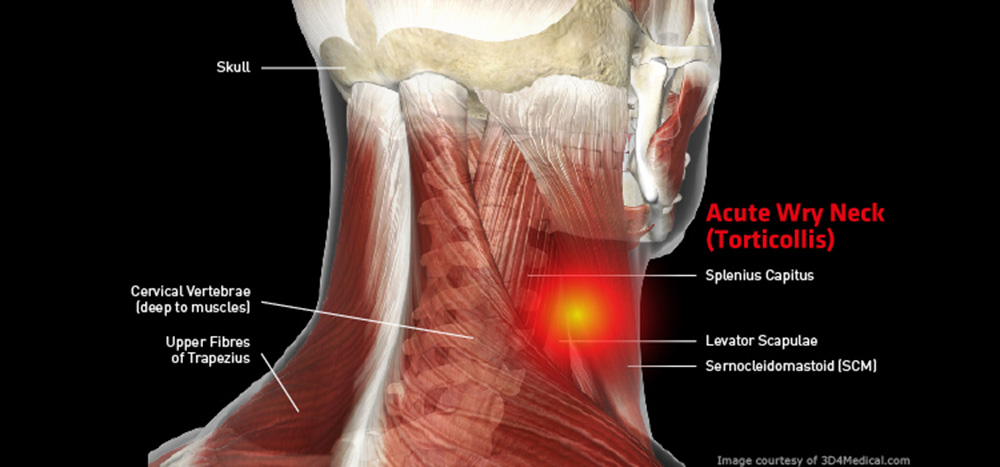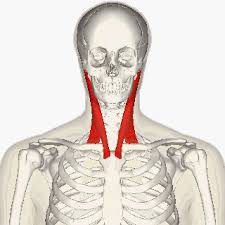
Wry Neck
Ever heard that term bandied around and wondered what the heck it means, well, read on….and maybe even pick up a tip or two on how to address it!
The medically correct term for wry neck is ‘acute torticollis’, but let’s break it down and make it look less technical.
Acute: in medical terms relates to something of recent onset.
Tortus: in latin means ‘twisted’.
Collum: in latin refers to ‘neck’.
So when a patient who presents to our clinic with their head ‘off-kilter’ and in a decent amount of discomfort, we have a pretty good idea (on first impression) as to what is going on. Having said that, as osteopaths we won’t immediately jump to conclusions, and will still run through a thorough history and examination process to arrive at a provisional diagnosis.
Once we have ascertained there are no red flags (neurological deficits, a preceding trauma, signs of infection etc.), we will then try to get a deeper understanding as to what may have ‘set’ this episode off. Bear in mind, a wry neck can occur insidiously (that is, for no apparent reason), but over the years we have anecdotally seen potential triggers such as:
- A complication from birth (poor bub’s head is held in an abnormal position in utero, or during labour the forces on the neck muscles triggers a protective muscle spasm). As a result, it is not uncommon for us to treat babies in the clinic.
- Moving from bubs to the feeding parents (especially breast feeding mums), spending excessive amounts of time with the head held in non-neutral positions (ie flexed, side bent and rotated) can create adaptive shortening of key neck muscles, especially one called the sternocleidomastoid (let’s call it SCM for short! – pictured below).

- Some other examples of abnormal head positioning can include dozing on the couch (you know that position; head slumped forward tilted slightly towards the armpit, with a little trace of dribble at the side of your mouth). What about sleeping on a different pillow (especially one that is too high for you), going for too much on that bench press in the gym and straining every muscle (including your neck muscles), and maybe even getting into that play fight (think over-zealous head lock on that bucks/hens night!).
So now you know a little more about it, how do we fix it?
Remember these 3 key words – RELAX, BREATHE and STRETCH.
Relax:
Yes, that’s right. Although it can be very painful, rest assured that in most cases this injury/condition is self-limiting and will often sort itself out over a 3-7 day period. Getting anxious/wound up/stressed about it will only exaccerbate the problem. So don’t try and fight it and force your head back to normal, just know that over the coming days a slow and steady return to normal range of motion (ROM) will occur. This is where the role of the osteopath can be very important, as the introduction of soft tissue massage to the affected muscles may release spasm and improve blood flow, and using passive manual movement may aid in gradually restoring head and neck ROM.
Breathe:
This might sound obvious, but if you analyse your breathing closely, take a fuller breath and take note where the majority of your breathing is coming from. You may be surprised to see your shoulders elevate more than you realised and you feel fuller in the upper chest. Now this isn’t all bad, but the implication can be that you may be under-utilising your diaphragm (our Primary breathing muscle lining the inside of our rib cage) and over-utilising your accessory breathing muscles (which includes our offending SCM muscle, and trapezius muscles). Consulting with an osteopath may be quite helpful as we can apply treatment techniques to these ‘breathing’ muscles and the supportive thorax, and also provide instruction on optimal breathing patterns.
Stretch:
Let’s keep this simple; in the case of a wry neck you are most likely to suffer significant tightening in and around the neck region. As mentioned previously, it is important to regain ROM asap, so being armed with some appropriate neck and upper back stretches can assist with this goal. Additionally, the use of heat therapy (such as topical heat creams and wheat bags) may also have a positive therapeutic effect.
Hopefully this gives you a clearer insight into what can be a random, yet somewhat common condition, and should you require treatment or further advice for a wry neck please do not hesitate to contact us at Parkdale Osteopathic Clinic on 9580 1820 or book online here



